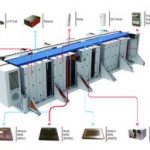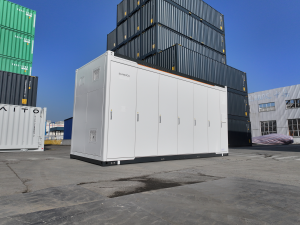https://www.tlc-yz.com/product/containerized-integration/energy-storage-container/
Energy storage has become a critical area of research and development in the face of increasing global demand for sustainable energy solutions. As the world shifts away from fossil fuels, energy storage containers play a pivotal role in balancing supply and demand, enhancing grid stability, and maximizing the efficiency of renewable energy sources. It is any system or device used to store energy that can be released when needed, and these systems come in various forms, depending on the energy type, capacity, and intended application.
In this article, we will examine the main types of energy storage systems, detailing their technology, advantages, and applications. These include mechanical, electrochemical, chemical, thermal, and electrical storage, each offering distinct benefits based on the use case. This comprehensive overview will clarify the fundamental role these systems play in modern energy frameworks.
1. Mechanical Energy Storage Containers
Mechanical energy storage containers utilize physical forces and motions to store and release energy. They are characterized by their ability to store large amounts of energy and release it quickly. The two primary types are pumped hydro storage and flywheel storage.
a) Pumped Hydro Storage
Pumped hydro storage is one of the most widely used energy storage technologies globally, accounting for the majority of the world’s stored electricity. This system works by using excess electricity to pump water from a lower reservoir to a higher one. When energy is needed, the water is released back to the lower reservoir, passing through turbines that generate electricity.
- メリット High energy capacity, long-duration storage, and high efficiency (typically 70-85%).
- Challenges: Requires significant land and water resources, and geographical limitations (needs elevation differences).
- Applications: Primarily used for large-scale energy storage on the grid, particularly to support renewable energy sources like wind and solar.
b) Flywheel Energy Storage
Flywheel energy storage containers store energy in the form of rotational kinetic energy. When energy is introduced into the system, it spins a rotor (flywheel) at high speeds. When electricity is needed, the system slows the rotor down, converting the rotational energy back into electrical energy.
- メリット High power density, long lifespan, fast response times, and low maintenance.
- Challenges: Limited energy capacity compared to other systems, and relatively high cost.
- Applications: Flywheels are often used in applications requiring quick bursts of energy, such as uninterruptible power supplies (UPS) and frequency regulation on the grid.
2. Electrochemical Energy Storage Containers

They are based on chemical reactions within batteries to store and release energy. Batteries are among the most versatile and widely used energy storage containers due to their scalability and flexibility across different applications. There are several types of batteries, but the most prominent for energy storage include lithium-ion, lead-acid, and flow batteries.
a) Lithium-Ion Batteries
Lithium-ion (Li-ion) batteries are the most popular electrochemical energy storage containers today, primarily because of their high energy density, lightweight design, and efficiency. They work by moving lithium ions between two electrodes during charging and discharging.
- メリット High energy density, long cycle life, and fast charging/discharging rates.
- Challenges: High cost, limited availability of raw materials, thermal runaway risks (potential for overheating), and degradation over time.
- Applications: Used in electric vehicles, consumer electronics, and increasingly in grid-scale energy storage systems.
b) Lead-Acid Batteries
Lead-acid batteries are one of the oldest types of energy storage containers, known for their reliability and low cost. They store energy through a reversible chemical reaction between lead and sulfuric acid.
- メリット Low cost, robust and reliable technology, widely available.
- Challenges: Low energy density, shorter cycle life, and environmental concerns due to lead toxicity.
- Applications: Commonly used for automotive applications (starting engines) and backup power systems.
c) Flow Batteries
Flow batteries differ from conventional batteries in that they store energy in liquid electrolytes contained in external tanks. The energy is generated when the liquid flows through a reaction chamber, and it can be scaled up by increasing the size of the electrolyte tanks.
- メリット Scalable capacity, long lifespan, and minimal degradation over time.
- Challenges: Low energy density, high initial costs, and complex system maintenance.
- Applications: Best suited for large-scale, long-duration energy storage, particularly in renewable energy integration and microgrid applications.
3. Chemical Energy Storage Containers
Chemical energy storage containers store energy in the form of chemical bonds, which are released when the bonds are broken. The two most important types of they are hydrogen storage and synthetic fuel storage.
a) Hydrogen Storage
Hydrogen is a versatile energy carrier that can be used to store and transport energy. Hydrogen energy storage containers involve producing hydrogen through electrolysis (using electricity to split water into hydrogen and oxygen), which can later be converted back into electricity using fuel cells or combustion.
- メリット High energy density, can be stored for long periods, and produces zero emissions when converted back to energy.
- Challenges: Hydrogen production is currently expensive, storage and transportation are complex, and infrastructure is limited.
- Applications: Hydrogen storage containers are expected to play a key role in large-scale energy storage, transportation, and industries aiming to decarbonize sectors like steel production and heavy transport.
b) Synthetic Fuels
Synthetic fuels are another form of chemical energy storage. They are produced by using renewable energy to convert CO2 and hydrogen into liquid fuels like methanol or synthetic gasoline. These fuels can be stored and used in conventional engines or power plants.
- メリット Compatible with existing infrastructure, high energy density, and potential for carbon-neutral applications.
- Challenges: High cost and inefficiency compared to other energy storage containers, as the production of synthetic fuels is energy-intensive.
- Applications: Mainly used in sectors where electrification is difficult, such as aviation, shipping, and heavy industry.
4. Thermal Energy Storage Containers
Thermal energy storage containers store energy by heating or cooling a medium and then releasing the energy as heat or cold when needed. These systems are particularly valuable for balancing supply and demand in heating and cooling systems or integrating with renewable energy systems like solar power. The two primary forms of thermal storage containers are sensible heat storage and latent heat storage.
a) Sensible Heat Storage

Sensible heat storage containers store thermal energy by increasing the temperature of a solid or liquid, such as water or molten salt. The energy is stored in the material as heat, which can be released when needed by allowing the material to cool.
- メリット Simple technology, relatively low cost, and scalable.
- Challenges: Limited energy density and significant heat loss over time.
- Applications: Commonly used in solar thermal power plants and district heating systems, where large-scale heat storage is required.
b) Latent Heat Storage
Latent heat storage containers rely on phase change materials (PCMs) to store energy. PCMs absorb or release energy when they change from one phase to another, such as from solid to liquid or liquid to gas.
- メリット Higher energy density than sensible heat storage, and more efficient storage and release of energy.
- Challenges: PCMs can be expensive, and there is limited availability of suitable materials for large-scale applications.
- Applications: Used in building heating and cooling systems, as well as in industrial processes that require thermal management.
5. Electrical Energy Storage Containers
Electrical energy storage containers store energy directly in the form of electric fields. While not as common as mechanical or electrochemical systems, these technologies are important for specific applications. The main types include supercapacitors and superconducting magnetic energy storage (SMES) systems.
a) Supercapacitors
Supercapacitors, also known as ultracapacitors, store energy in electric fields between two conductive plates. They can store and release energy quickly, making them useful for applications requiring high power output for short durations.
- メリット High power density, long cycle life, and fast charging/discharging times.
- Challenges: Low energy density compared to batteries and high cost.
- Applications: Used in applications such as electric vehicles, grid stabilization, and regenerative braking systems.
b) Superconducting Magnetic Energy Storage (SMES)
SMES systems store energy in the magnetic field generated by the flow of direct current through a superconducting coil. When energy is needed, the current is discharged, releasing the stored energy.
- メリット High efficiency, fast response times, and unlimited cycle life.
- Challenges: Extremely high cost, the need for cryogenic cooling, and complex maintenance requirements.
- Applications: Mainly used for grid stability and short-duration energy storage in specialized applications.
結論
Energy storage containers are indispensable in modern energy systems, providing a range of solutions for storing energy generated from renewable sources, balancing grid supply and demand, and ensuring energy availability during outages or periods of high demand. From mechanical systems like pumped hydro and flywheels to electrochemical systems such as lithium-ion and flow batteries, the diversity of energy storage technologies reflects the wide range of applications and requirements in today’s energy landscape. As technology advances, the efficiency, cost, and capacity of they will continue to improve, playing an even more vital role in the global transition to a sustainable energy future.
CIMC TLC|XLC|RYC is a leading manufacturer of energy storage containers and various other standard and special logistics equipment. With years of experience in the industry, it focuses on the design, production and distribution of high-quality innovative products that meet the specific needs of customers.
冷蔵コンテナ、コールドチェーン設備、コンテナ型設備統合、モジュール式建物など、高品質で革新的な物流設備が必要な場合、 CIMC TLC|XLC|RYC はあなたの最良の選択です。世界中のお客様からのお問い合わせを歓迎し、あなたと協力する機会を楽しみにしています。
文章简述:Energy storage containers, including mechanical, electrochemical, chemical, thermal, and electrical systems, are essential for balancing supply and demand in renewable energy, enhancing grid stability, and ensuring energy availability across various applications.


